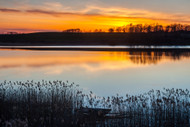What You Should Know About Crappie Habitats for Fish
Posted by Fish Hiding on 2nd Oct 2024
Crappie, a popular freshwater game fish, are known for being elusive and highly sought after by anglers. Luckily, artificial crappie habitats have become a crucial tool in creating environments where crappie thrive. If you’re considering buying artificial fish habitats, it’s important to know how these structures can help mimic the natural environment crappie seek.
Natural Crappie Habitats
Crappies typically prefer environments with a lot of underwater cover. This includes submerged trees, brush piles, weeds, and rocks. These elements offer crappie protection from predators and serve as prime locations for feeding, as they attract smaller baitfish and invertebrates. Additionally, crappie are more likely to spawn in areas with plenty of cover, which provides protection for both the adult fish and their eggs.
Water clarity, temperature, and depth are also important factors. Crappies tend to favor clear, cool waters that are between 10 and 20 feet deep. They are known to move deeper in the summer and shallower in the spring during spawning season. By understanding these preferences, you can create a habitat that meets their needs and increases your chances of attracting crappie to specific areas. Vertical cover is proven to be the preferred cover/habitat for Crappie in all waters, clear and stained.
Benefits of Artificial Fish Habitats
Artificial fish habitats can replicate the structures crappie naturally seek, making them a great investment for anyone who wants to create a sustainable fishing environment. These structures are made from Fishiding.com, with reclaimed materials and can be placed strategically in lakes, ponds, or other bodies of water to encourage crappie populations.
One of the main benefits of artificial habitats is their durability. Artificial crappie habitats made from reclaimed PVC resist decay and require no maintenance, providing long-term benefits. They also allow you to design the ideal layout for crappie, ensuring that the habitat includes features like nooks and crannies where smaller fish and aquatic life can thrive, attracting crappie to feed and spawn.
Choosing the Right Artificial Habitat
When selecting artificial habitats for crappies, look for products designed specifically for freshwater environments. Here at Fishiding, we offer a range of habitats that are built to withstand various water conditions while mimicking the natural structures crappie are drawn to. You should consider the size and shape of the habitat, as well as how it will fit into your lake or pond's ecosystem.Models can range from about 3’ tall to over 15’ tall.
By understanding crappie behavior and choosing high-quality artificial habitats, you can create a thriving environment that supports both crappie and other aquatic species they feed upon. To learn more or get started with your own artificial crappie habitats, get in touch with our team today at Fishiding Reclaimed Artificial Fish Habitat!



